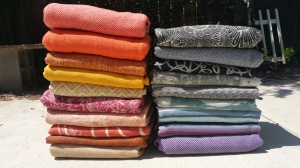
This may come as a shock to some of you – but I LOVE woven wraps. They are beautiful. They can be one of the most fashionable accouterments to motherhood, giving me confidence when I am out in the world. They are something that allows me to maintain some semblance of my former self, in a daily routine that is completely centered around my child now. It is no wonder that so many of us have fallen head over heels for these pieces of woven fabric. In order to help guide you on your journey into the world of woven wraps, I have put together this primer. It is a lot of information, but I broke it up into clear sections so you can skim to find an answer to your burning questions. May your wrappees be cooperative, may your arms be ever flexible, and may you find your DISO at or below market value. Welcome you to the world of woven wraps. ❤
What is a woven wrap?
Simply put, a Woven Wrap is a long piece of woven fabric used to carry your baby. Some have tapered ends, some have blunt ends. They can be woven from many different materials, and made in many different regions of the world. They range in price from $80.00 – $1 million unicorn hairs.
Why do I want one?
A woven wrap is the most versatile carrier you can own. It can be used from the day your baby is born, until they outgrow being worn. Most woven wrap manufacturers recommend a Maximum weight of 45-50 lbs, but I have seen many photos of adults wearing other adults in wovens, or using woven wraps as a hammock… so in my personal experience…. The upper weight limit of a woven wrap has more to do with the comfort of the wearer than it does the weight of the child.

A woven wrap can be tied so many different ways, it can accommodate the needs of the majority of wearers. You can use it in a front carry, back carry, hip carry, an asymmetrical carry, torso carry… you can use a chest belt, a waist belt, however you find it most comfortable! You can buy some Sling Rings to try out some fancy finishes, and open up a whole new world of carries with the same ol’ length of fabric. Seriously, the possibilities are endless.
So if you are one of those people who truly believes you only want one carrier to get you through your kid’s wearing years , or you are on a tight budget and don’t want to keep trying different carriers until you find one that works – a Woven Wrap can be a very solid choice for your family.
Do they come in different lengths? Which is best for me?
A Woven Wrap is measured in meters. To make it easier on all of us who don’t use meters, they are most commonly referred to in “Sizes”.
Size 2: 2.7 meters
Size 3: 3.1 meters
Size 4: 3.6 meters
Size 5: 4.2 meters
Size 6: 4.6 meters
Size 7: 5.2 meters
Size 8: 5.6 meters
The size of wrap you need can vary. Most people begin with what we refer to as your base size, which is a recommendation based on your t-shirt size, rather than your height or your baby’s size. Your base size, is the length of fabric you need to do a Front Wrap Cross Carry (FWCC) and tie behind your back. For the majority of average sized wearers, a Size 6 is considered “Base” while a petite wearer could use a 5, and a Plus-size wearer would go with a 7.
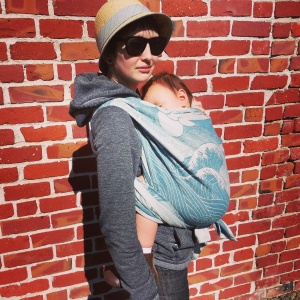
The funny thing about woven wraps, is the size is actually pretty arbitrary. Though most educators recommend beginning with your base size and a FWCC, you could instead buy a really short wrap and begin with a Traditional Sling carry instead! Or you could buy a wrap that is your base size -1 and easily do another variation of the FWCC, such as the “tied under bum” version or the “tied at shoulder” version. The pre-tied Front Cross Carry is also a great first carry, and you can use your base size – 1 for that carry too! You could even use Sling Rings to finish a carry that you otherwise would not have had enough length to tie off. Bottom line, is you don’t NEED to begin with one specific size, it is just easier to follow the progression of wrapping that typically begins with your base size and a FWCC.
What are the different fiber contents? Which one is the best?
This is like asking which kind of Micro Brew is the best. You are going to get a million different answers depending on who you ask, where they are from, what the weather is like there, and what their geek level is on the subject. That being said, this is my personal take on fabrics after spending the last 3 years wearing and wrapping with literally hundreds of wovens.

100% Cotton: Hands down the best bet for a first time wrapper. Easy to maintain, easy to break in, affordable, soft, supportive enough for whatever baby you want to wrap. If you are thinking you are a “one and done” kinda family, you probably want to go with just a basic cotton wrap. Something with stripes is easier to learn on visually, so that may be a good place to start.

Linen: My second choice if you are thinking you only want to get one wrap in your whole life. Most linen wraps are going to be mixed, some portion cotton and some linen. There are a few companies out there that make 100% linen wraps, but they can be pretty hard to break in – so I don’t often recommend them for new wearers. Linen is incredibly supportive, so it a solid choice for a heavy toddler in a multi-pass carry. It is also thin and breathable, so it is often one of my top recommendations for someone looking for a wrap specifically for hot weather. These things can be washed and dried and thrown around – no fuss kinda fabric. Despite the effort some linen wraps take to break in, once they get there… they are amazing. My linen blend wraps are among the softest in my stash now.

Hemp: Another easy to care for fabric, hemp also offers the support and breath-ability that linen does. It tends to be a little thicker than linen, and definitely more expensive. I have found that most hemp wraps come feeling pretty crunchy right out of the package, but the majority of them break in quite nicely after a few washes and some wear. Some people swear by hemp for the heat of summer. The few hemp wraps that I have owned have not gotten much love over here… I just grab for the linen or 100% cotton most of the time.
Wool: Totally awesome, soft and amazing. Supportive, breathable, beautiful. Why have I never owned one then? Same reason I didn’t use wool diaper covers. It is too stinkin hard to take care of. People always tell me “It’s not that hard to care for! I just [insert long list of totally improbable care instructions including things like hand washing, patting dry with towels, conditioning, etc]”. Babies are little balls of poop, pee, spit up and snack foods. I want something I can just throw in the wash. Some of you might be into that kind of thing… but it is just not for me. For that reason I never recommend wool or keep it in my stash.

Silk: I actually love silk for smaller babies. I have owned a couple silk wraps in my time, they are incredibly soft and glide so smoothly. As my daughter started to get bigger though, I experienced a lot of digging on my shoulders – it started to feel a lot like a rope carrying all her weight. For that reason I swore off silk for a while. I have recently had the opportunity to host some much thicker silk blend wraps, and am happy to say they were totally comfortable for my toddler. So if looking at silk, make sure it is a weight and thickness appropriate for the child you are wearing. Silk is supposed to be hand washed in lukewarm water and hung out to dry not in direct sunlight. I actually throw mine in the wash on the hand wash setting, no problems yet.

Bamboo: A bamboo blend wrap is so soft and awesome for a newborn, but it is not appropriate support for a toddler. It is also pretty slippery to wrap with, so I don’t often recommend it to new wrappers, as it can be extremely frustrating to properly tighten. Another one for the “hand wash” category. Clearly not my first choice, though I have owned quite a few. The softness gets me every time.
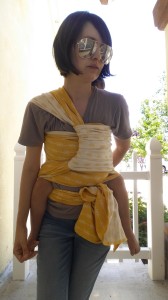
Sustainable Blends: There are all kinds of new manufacturers and new materials coming out to get excited about if sustainability is your stick. The majority of them are soft after just one wash, break in with no effort, and are affordable to boot. They are soft enough for a newborn, but offer amazing support for toddler’s too. Super easy to take care of also. Most of them can just be throw in the wash. The main criticism I hear, is over the blending of synthetic materials into the woven wraps. A lot of people are really against this practice. I am on the fence about it. I love the sustainability aspect, but myself am a huge fan of natural fibers. Though I have wrapped with many of these blends, I have not purchased one as of yet. If you are concerned, do some research first to see what the synthetic yarn is composed of. Some of the sustainable blends to check out are Repreve (made from recycled water bottles), Tencel (made from Eucalyptus pulp and not considered synthetic), and Eco2Cotton (made of recycled fabric scraps – including some polyester).
How can I tell which one is thick or thin or good for beginners or newborns?
The thickness of a woven wrap is measured by its weight – Grams per meter squared. For most people new to wrapping, this is just a little too much geekery. I will admit it took me years to start to become interested in what the g/m2 is on a particular wrap. Here is a loose categorization of wrap weights, which can vary somewhat depending on the person writing it.
Really Thin: up to 180 g/m2
Thin: 180 – 220 g/m2
Medium: 220 – 260 g/m2
Thick: 260 – 300 g/m2
Very Thick: 300 g/m2
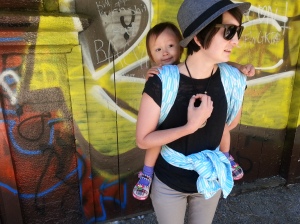
The Woven Wrap Database has this weight information, as well as listings for many Limited Edition wraps which includes their g/m2. Nowadays it helps me to determine what length I am going to need to be able to use that wrap. If a wrap is under 220 g/m2 I am going to need a base size in order to do a more supportive multi-layer carry. If something is weighing in at a beastly 300 g/m2 +, I am going to get something shorter that I can use in a quick single pass carry like a ruck, and I will know that it is going to wrap short because of the thickness.
If you are a new to wrapping, it is best to learn on a thin to medium wrap… maybe even very thin if you have a newborn. Something thick is going to be harder to manipulate, harder to tighten, and give you a super huge knot to try and work with.
What’s the lowdown on Handwovens? Are they worth mortgaging my house over?
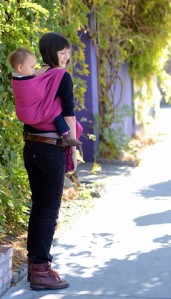
The handwoven craze is a little bit of an anomaly to me. Just like anything that people collect, there are fanatics that would spend thousands of dollars on some of these handwoven pieces. There are artisan weavers out there weaving some exceptionally beautiful stuff, but all of the artisan handwovens I have tried have not had wrapping qualities that far exceeded those of the machine woven wraps, or even other handwoven wraps that are not considered “artisan”. There are actually quite a few woven wrap companies that are producing handwovens at a fraction of the price of some of these artisans. They may not be one of a kind works of art, but they share the same wrapping qualities. I recommend starting with some of these more budget friendly handwoven wraps if you are curious what all the hype is about. I can assure you, you are not missing out on anything if collecting woven works of art turns out to not be your thing.
What carry is appropriate for what age baby? (aka When can I wrap the baby on my back?)
The easiest carry to start with, is a Front Wrap Cross Carry. It helps you learn the skills you will need to be a successful wrapper, and to practice them over and over. You can do this with a newborn, and continue to do it until you can’t see over your kids head anymore.
Alternately, if you only have a short wrap, you can learn a Rebozo first, or a kangaroo carry.

Hip carries are usable with any size baby, with modifications. For example, a Traditional Sling Carry, Robin’s Hip Carry, or Poppin’s Hip Carry can all end with the baby centered on your body, rather than on your hip. So essentially, they can be a one-shoulder front carry. This allows you to use a shorter wrap or try out new carries with an infant. As the baby starts to grow and develops adequate head and torso control, they can be moved to your actual hip. This allows them to pivot their torso to see the world around them, which is very helpful for that stage that babies go through around 3-6 months where they become very curious. This is a nice alternative to a front facing out carry, definitely more ergonomic and comfortable for the wearer.
“What counts as head control? My 2 month old can lift their head up, the doctor says they have amazing head control for their age!” Lifting their head up for a few moments at a time, is not the same as having adequate head and torso control. I usually ask caregivers to hold their baby up, hands in their armpits and see what the baby does. If the baby’s head bobbles around or slumps forward after a few moments, they are not ready for a hip carry or a forward facing carry.
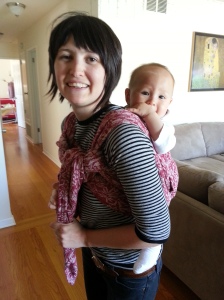
The recommendation is pretty similar for a back carry. If you are a first time wrapper, it is best to wait to do a back carry until your little one has adequate head and torso control. I am sure that many of you have seen tiny babies wrapped on people’s backs. Even as an experienced wrapper, I consider that an advanced skill. It is difficult to do, and there are numerous safety concerns if you don’t do it properly. For that reason, most educators err on the side of caution when making these recommendations. If you want to try it out – I highly recommend seeking help from a local Babywearing Group, or a Babywearing Consultant in your area.
Proper Positioning
High & Tight, Close Enough to Kiss, Visible and Kissable… all these are different phrases used to describe the ideal position in a baby carrier. You want the carrier to be tight without room for the baby to slump down into the carrier or else lean away from your body – which can really strain the wearer. It may not feel horrible at first, but after a while… your shoulders or upper back will start to ache.
The proper ergonomic positioning in the carrier finishes with your baby seated with the weight on their bum, and their knees brought higher than their bums in a position referred to as the “spread squat” or “M” position. This supports the natural curve of their spine, creating a comfortable and ergonomic carry for the both of you. I usually guide the baby’s legs into the proper position as I am making the seat for the carry.
Can I nurse in this carrier?

Short answer – yes. You can nurse in most carriers, but it can take a little bit of practice! I recommend first becoming familiar with your carrier, and be comfortable with nursing before you try to combine the two skills. Some may find that nursing in the carrier is not a hands-free process… but one hand free is better than no hands free! Don’t be discouraged if you don’t get it right away! It is one of those skills worth figuring out. I found nursing in a carrier to be a liberating experience. It really helped me to be the kind of parent I wanted to be, while still taking care of my own needs.

Some of my favorite carries for nursing, are Front Wrap Cross Carry, Front Cross Carry, Traditional Sling Carry, and Robin’s Hip Carry. I have use many others, but these are the ones that I felt were the most forgiving as far as moving the baby to the desired position easily and readjusting after nursing without much hassle.
What makes a wrap “Toddler Worthy”?
New to wrapping? Beginning with a toddler? It’s not too late! My kid was 10 months old already when we bought out first woven – and look at where we are now! Here are some things to keep in mind if looking for a great toddler wrap.

As I mentioned earlier, some fabric may not be as supportive for use with a toddler, so it is important to at least do a little research or read some reviews if your main wrappee is a giant. Another consideration, is the width of the wrap! The width can vary pretty dramatically from wrap to wrap, from 45 cm – 75 cm! A lot of the newer brands tend to be putting out pretty wide wraps compared to some of the older brands. I love the wide wraps with my toddler! Gives me much more fabric to make a deep seat with her, with enough fabric left at the top to give her neck support when she falls asleep. That much extra fabric can be really cumbersome with an infant, making it really hard to get a nice tight wrap job without too much bunched up fabric. This makes wider wraps really stand out for the toddler demographic.
Drawbacks to a woven wrap?
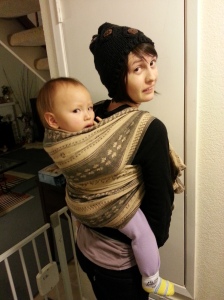
You mean, other than them being highly addicting? Seriously, it is difficult to avoid “going down the rabbit hole” once you fall in love with it. Just be forewarned!
Woven wraps have a very steep learning curve. All those meters of fabric can be quite intimidating for many new wearers. Some people just find it ridiculous to have to learn all these different carries, when they could just strap on a buckle carrier. But no buckle carrier can give me the weight distribution and aesthetic options that a woven wrap can! Wrapping is a skill. It takes practice to learn it, but it is a really amazing way to keep your child close to you – so many people take the plunge. If you find that you are someone who gets easily frustrated, practice with a stuffed animal or something like that so you do not have the added frustration of a crying baby while you are trying to figure out something unfamiliar. All the YouTube Videos in the world cannot substitute for real hands on help, so try to make it to a Babywearing meet-up in your area to learn all the tricks firsthand.
Where can I get one?
Most woven wrap buying seems to take place online. If you type “Woven Wrap” into Google you will get a myriad of options as far as purchasing new wovens online direct from the brands, or from a retailer. If you want to search for something that is not currently being made, or if you like the idea of a previously loved, well broken in carrier – you might want to check out The Babywearing Swap or Babywearing on a Budget. Both are very active Facebook Groups that are like online marketplaces for carriers. The Babywearer is also a great place to search for woven wraps secondhand. It is a little harder to navigate than the Swap, but there are some great deals there if you have the patience to look.
As always, this is my opinion on the subject. Feel free to message me if you have any questions or need some advice! I am happy to geek out over baby carriers any day of the week. Happy Wrapping! ❤
For a Glossary of some woven wrap descriptions, click here.
For a wonderful size chart for different carries with different length wraps, click here.

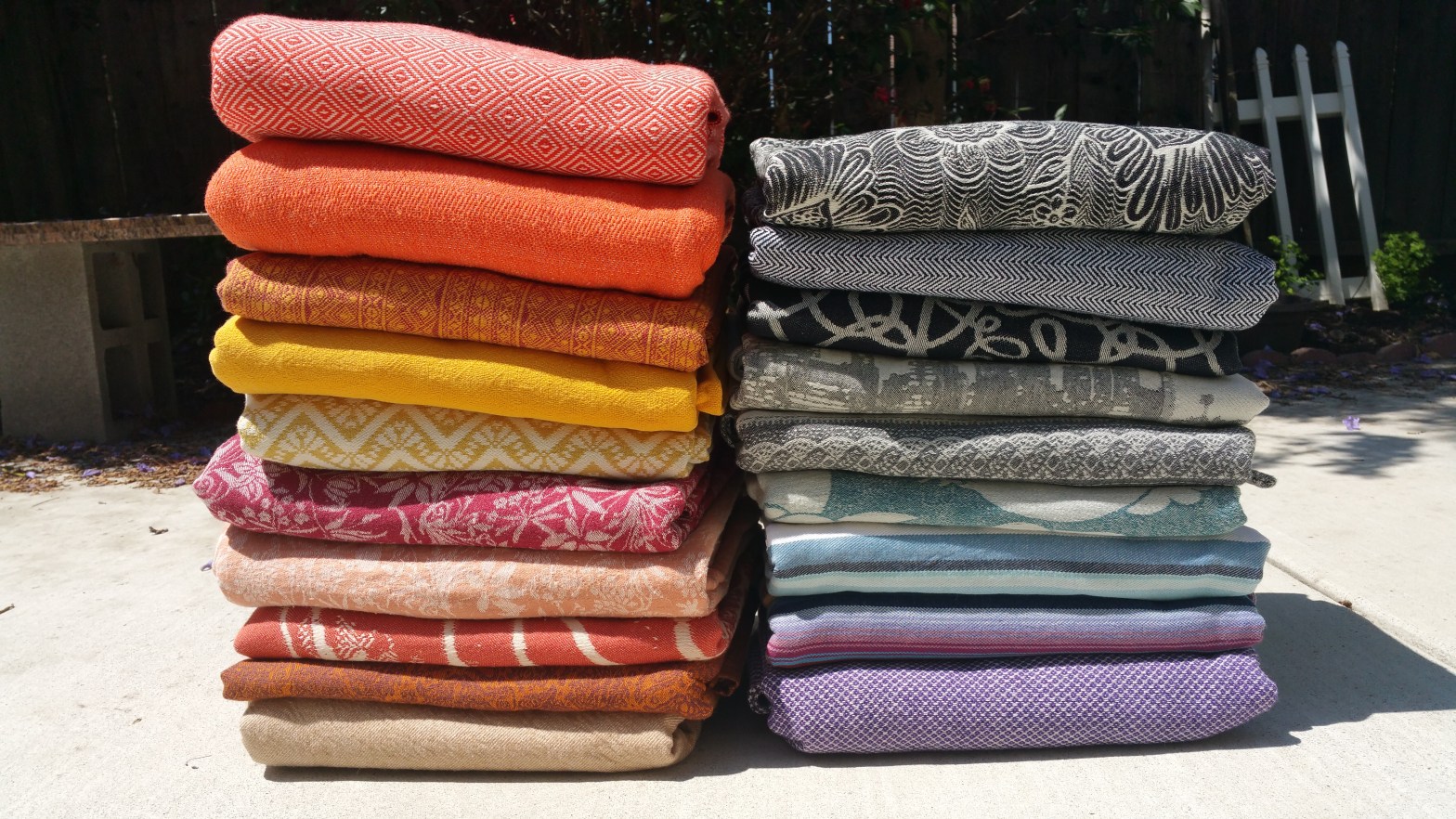
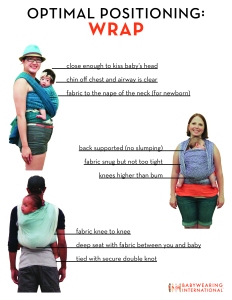
I was looking for places to find used baby wraps… This is the best article I could have possibly came across. Totally requested those 2 groups on Facebook! Thanks so much for this
Glad you enjoyed it! There was so much to take in when I was first learning about woven wraps,I wanted to try and demystify the learning process for others. 🙂
Thank you for the most helpful post I’ve read on wrapping! I now feel confident enough to buy and begin my babywearing journey!
hi! what is that last wrap in your babywearing fail picture? It looks like an Ellevill maybe? Thanks!
It’s a Natibaby Honsui 🙂
Wooowww, it’s so cool and very complete, thanks for the article, gonna bookmark this post. Anyway, what the cheapest woven wrap so far? cheapest but have a good performance^^
Hiya
I realise this is a fairly old post but it is fabulous and very detailed. Thank you for writing it. My little one is 15 months old and I have never used a woven wrap. We used stretchy wrap when she was tiny and I use a buckle carrier now but I find it isn’t that comfortable anymore. I like to carry her on my back but am worried about getting her there safely in a woven. Have you any tips for this and will I be able to do this so late on? I really love the idea of the wovenue but worried it will be too complicated to start using with a toddler.
I don’t think it’s too late! I started wrapping when my daughter was about 9 months old. They might be slightly more resistant, but also larger and easier to practice things like making the seat! I’m still wearing my almost 5 year old, so your wearing are as long as you want to make them. ❤
Ok Jay – I wanted to buy a woven and I read your post, I’ve got my new wrap and I’m practicing “my moves”.
Now I have a very practical question: How do you carry other stuff?
Never mind, bottles, diapers, wipes and all the other baby/toddler stuff that you need a bag, a car or a pack mule for…
Do you just have to have pockets for the basic: wallet, cellphone, keys?
Hi! That’s an awesome question! I took to using a backpack when front carrying, and a cloth cross body bag when back carrying. A lot of manufacturers of woven wraps actually make awesome wrap bags, so it gives me an excuse to feed my collector bug even when I can’t buy any wraps. 😉 Soul Slings, Kol Kol and Smitten all make some awesome bags.
Hi there! I am so glad I found this post, so informative!!! Brand new to babywearing with a woven. I have a 9week old boy that is in the 95percentile. I am looking for a wrap that could hopefully last a while. What would you recommend for a first time mom?
I would recommend something medium weight cotton or a cotton/linen blend to start off with. My usual suggestions for a new wearer might be different since your baby is so heavy already! Check out Smitten With Wovens, they are a great line for first time wrappers, and the weights are appropriate for newborn through toddler. Tekhni is another brand that comes to mind that has lots of nice medium weight wraps good for beginners. I recently have been testing a lot from Luluna Slings, and they are just great 100% cotton beater wraps. Best of luck!